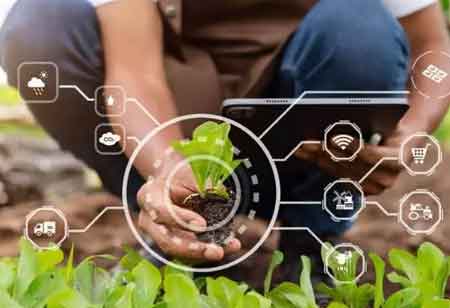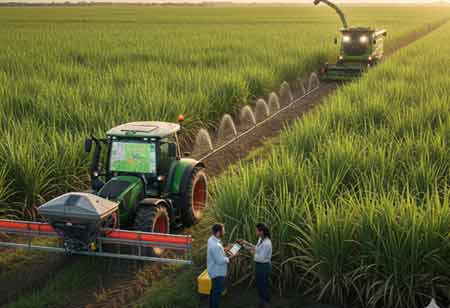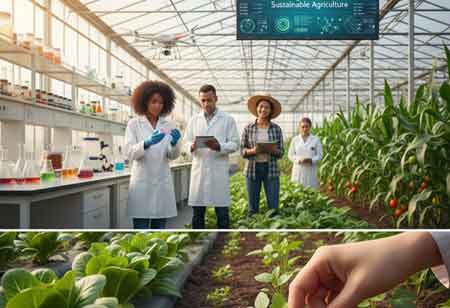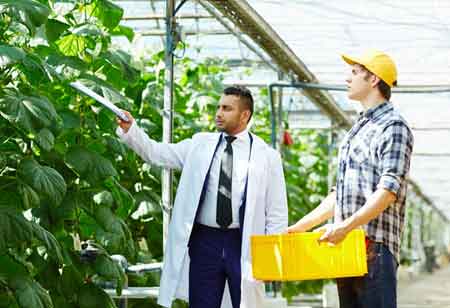Thank you for Subscribing to Agri Business Review Weekly Brief
Implementing Smart Agriculture with Effective Strategies
Smart agriculture, also known as digital farming, represents a revolutionary approach to modernizing the agriculture sector

By
Agri Business Review | Saturday, September 30, 2023
Stay ahead of the industry with exclusive feature stories on the top companies, expert insights and the latest news delivered straight to your inbox. Subscribe today.
Smart agriculture offers transformative potential for sustainability and productivity through data-driven decisions, connectivity, and precision farming. Commitment to sustainability, education, collaboration, and data security is crucial for success.
FREMONT, CA: Smart agriculture, also known as digital farming, represents a revolutionary approach to modernizing the agriculture sector. It harnesses technology, data, and innovation to optimise farming practices, increase productivity, and promote sustainability. As the global population continues to grow, and climate change challenges become more pronounced, adopting smart agriculture is increasingly imperative.
Embrace Data-Driven Decision-Making
A cornerstone of smart agriculture is the extensive use of data. By collecting, analysing, and interpreting data from various sources, farmers can make informed decisions that lead to improved yields and resource utilisation. Here are some strategies for leveraging data in smart agriculture:
Sensor Technology: Implement sensor-based systems to monitor soil conditions, weather patterns, crop health, and livestock behaviour. These sensors provide real-time data, enabling farmers to make timely decisions and take preventive actions.
Satellite Imagery and GPS: Utilise satellite imagery and GPS technology to generate accurate field maps, aiding in the optimisation of planting, irrigation, and harvesting processes, ultimately reducing waste and improving resource utilization.
Data Analytics: Invest in data analytics tools and platforms capable of handling extensive datasets. These advanced analytics solutions can offer valuable insights into crop well-being, pest control strategies, and crop yield forecasts.
ML and AI: Utilise ML algorithms and AI to predict crop diseases, optimise fertiliser usage, and implement automation in farm equipment to enhance operational efficiency.
Connectivity and Communication
To fully realise the potential of smart agriculture, it's crucial to establish robust connectivity and communication infrastructure:
Internet of Things (IoT): Implement IoT devices on the farm to enable seamless data collection and transmission. These devices monitor equipment performance, animal health, and environmental conditions.
5G Technology: Utilise 5G networks to harness high-speed, low-latency connectivity, which is imperative for real-time data transmission, and essential for both autonomous machinery and remote monitoring.
Cloud Computing: Farmers can leverage cloud-based platforms for storing and managing agricultural data, enabling convenient information access from any location, thus promoting collaboration and data sharing among various stakeholders.
Precision Farming Practices
Smart agriculture encourages precision farming techniques that optimise resource use while minimising waste:
Variable Rate Technology (VRT): Ensure the precise application of inputs such as fertilizers, pesticides, and water. VRT takes into account variations in soil composition and crop needs throughout different sections of the field.
Drones and UAVs: Employ drones for aerial surveys and crop monitoring, enabling the rapid identification of areas experiencing stress or disease, and facilitating precise and targeted interventions.
Autonomous Machinery: Invest in autonomous tractors, harvesters, and robots to operate continuously, lower labour expenses, and enhance the efficiency of planting and harvesting operations.
Smart Irrigation: Install smart irrigation systems that adapt water usage according to current weather conditions and soil moisture levels, effectively preventing excessive irrigation and promoting water conservation.
Sustainable Practices
Smart agriculture and sustainability go hand in hand
Crop Rotation and Diversity: Promote crop rotation and diversification to enhance soil health, mitigate the threat of pests and diseases, and bolster overall farm resilience.
Integrated Pest Management (IPM): Adopt IPM approaches that leverage data for precision pest control, reducing reliance on chemical pesticides and mitigating harm to beneficial insects.
Conservation Tillage: Embrace conservation tillage methods to reduce soil erosion, improve water retention, and sequester carbon, contributing to soil health and climate change mitigation.
Organic Farming: Explore organic farming techniques that rely on natural inputs and sustainable practices, often commanding premium prices in the market.
Investment in Education and Training
For successful smart agriculture implementation, invest in education and training for farmers and agricultural workers:
Digital Literacy: Offer training programs to improve digital literacy among farmers, covering the effective utilisation of smartphones, tablets, and agricultural applications.
Technical Skills: Conduct workshops and courses on the use of specific technologies like GPS, sensors, and data analytics tools to empower farmers to leverage these tools to their full potential.
Knowledge Sharing: Facilitate knowledge sharing and collaboration among farmers by creating communities or forums where they can exchange ideas and experiences, accelerating the adoption of smart agriculture practices.
Financial Support and Incentives
Governments and organisations play a vital role in promoting smart agriculture by offering financial support and incentives:
Grants and Subsidies: Provide grants or subsidies to farmers for purchasing smart agriculture equipment and technology, lowering the initial investment barrier.
Tax Incentives: Offer tax breaks to businesses and farmers that adopt sustainable and smart agriculture practices, encouraging widespread adoption.
Research Funding: Allocate funding for research and development in smart agriculture, leading to the creation of new technologies and innovations.
Smart agriculture represents a significant opportunity to transform the agricultural sector into a more sustainable, productive, and resilient industry. By embracing data-driven decision-making, fostering connectivity, and implementing precision farming practices, businesses can harness the full potential of smart agriculture. Furthermore, a commitment to sustainable practices, education, financial support, collaboration, and data security is essential for its successful implementation. As the world faces growing food security challenges and environmental concerns, the adoption of smart agriculture is a strategic choice and a necessity for a better and more sustainable future.
More in News





